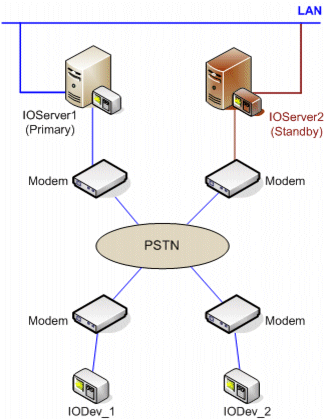
If you are using Server redundancy, Persistence Caches (I/O Server cache) keep standby servers updated with the most recently read device data. A Persistence Cache, or I/O Server Cache, is created for each cached I/O Device. The following diagram introduces the concept of a Persistence Cache.

The diagram shows that there are two I/O Servers,
namely IOServer1 (primary) and IOServer2 (standby). Each connects
to the public switched telephone network (PSTN ) via a modem, which is in turn connects
to the I/O Devices, also over a modem. Persistence Caches work as
follows:
) via a modem, which is in turn connects
to the I/O Devices, also over a modem. Persistence Caches work as
follows:
Note: You can define an I/O Device on an I/O Server using the Express Communications Wizard, or by adding a device in the I/O Devices form in CitectSCADA's Project Editor.
You are not limited to just one Standby Server, since the UNC path name set in [IOServer]SaveNetwork is broadcast to I/O Servers. Each I/O Server updates its cache from the Persistence Caches only for the I/O Devices defined on that server. It is then possible, therefore, set up several I/O Servers which update their in-memory caches with the most recently read data.
For example, we set the [IOServer]SaveFile and [IOServer]SaveNetwork parameters as follows:
|
On IOServer1 |
On IOServer2 |
|
[IOServer] |
[IOServer] |
|
SaveFile=C:\Data\IOServer1.dat |
SaveFile=C:\Data\IOServer2.dat |
|
SaveNetwork=\\IOServer1\Data\IOServer1.dat |
SaveNetwork=\\IOServer2\Data\IOServer2.dat |
IOServer1 would broadcast the following UNC path of the Persistence Cache to other I/O Servers: '\\IOServer1\Data\IOServer1.dat'. IOServer2 would then use the Persistence Caches to update its in-memory cache with the device data most recently read by IOServer1.
See Also